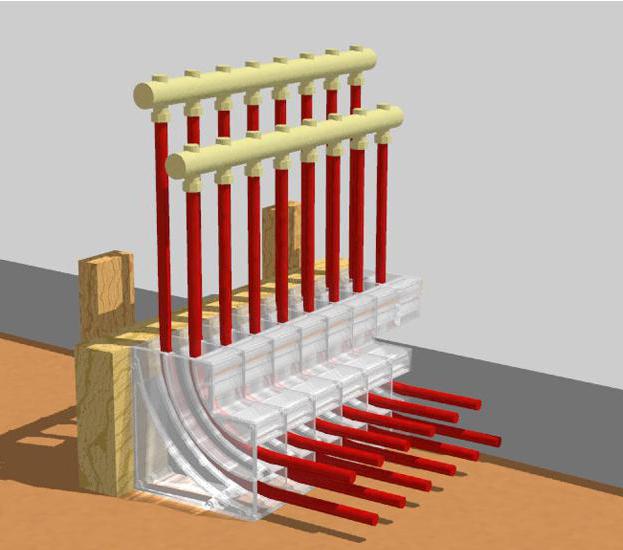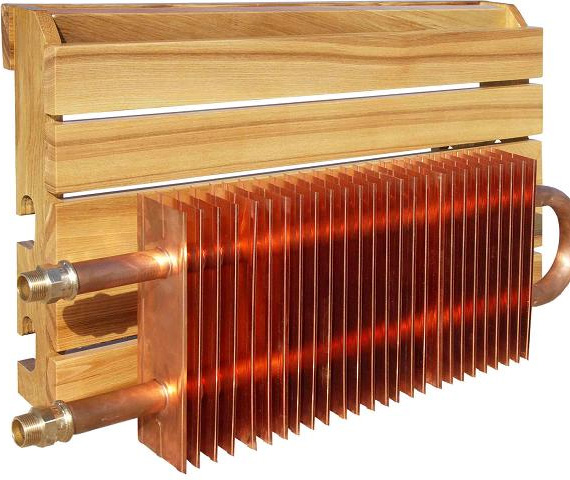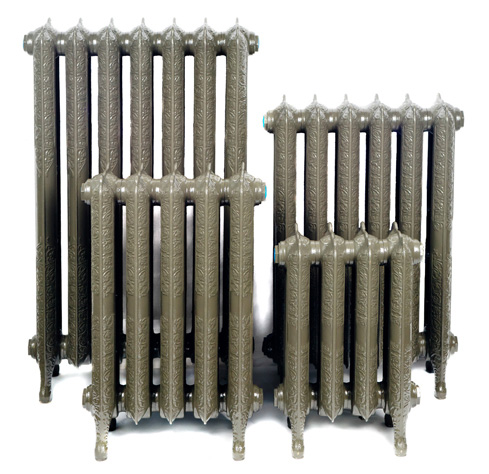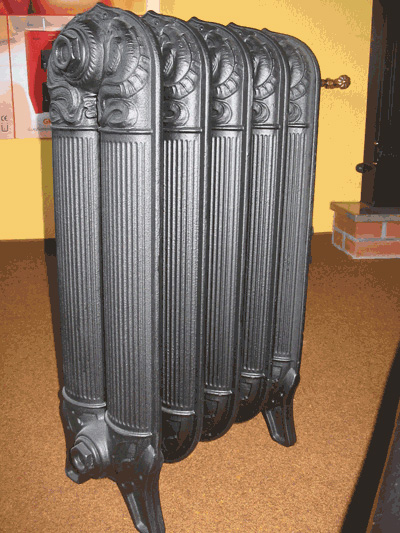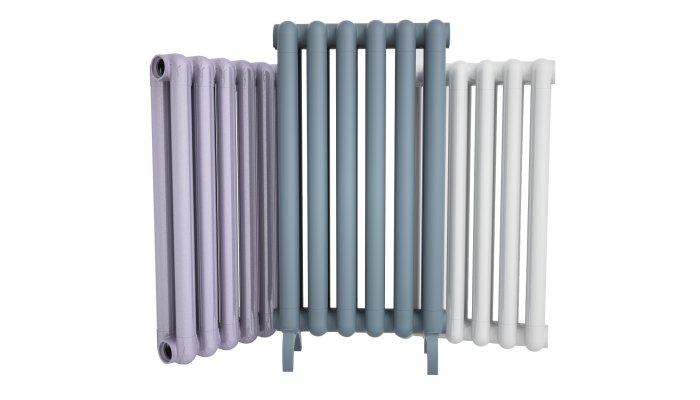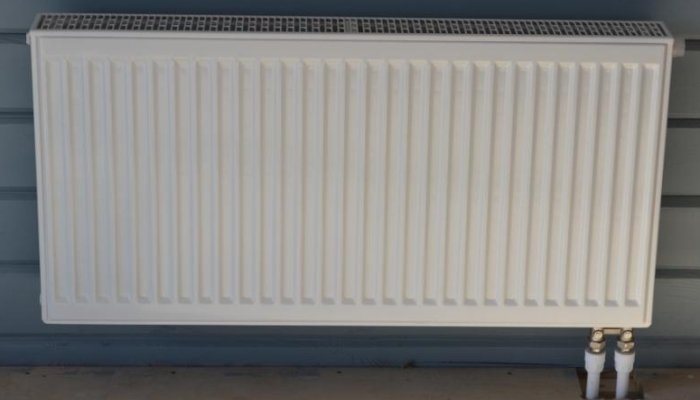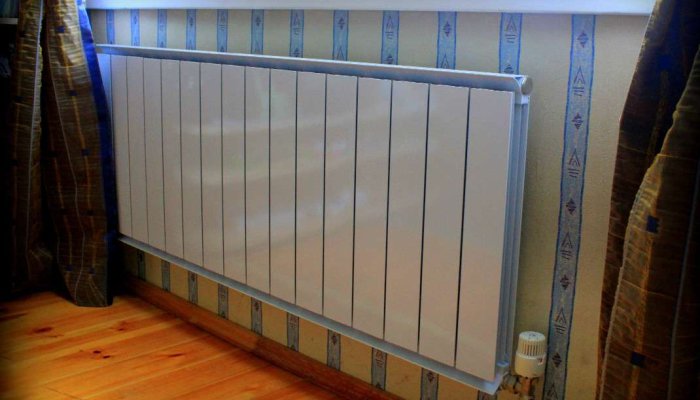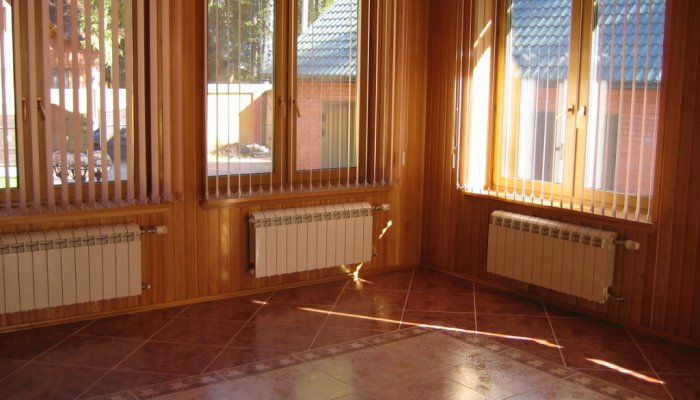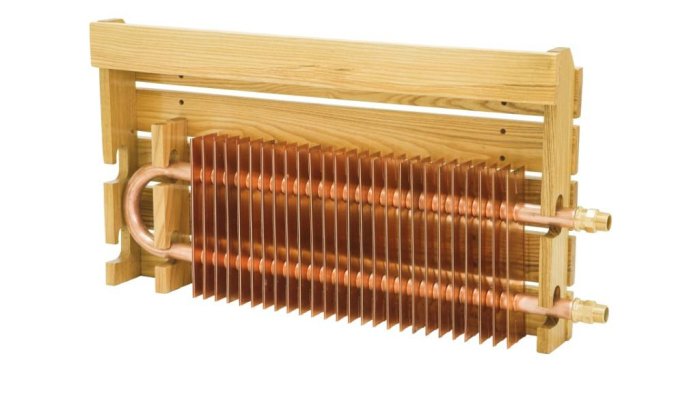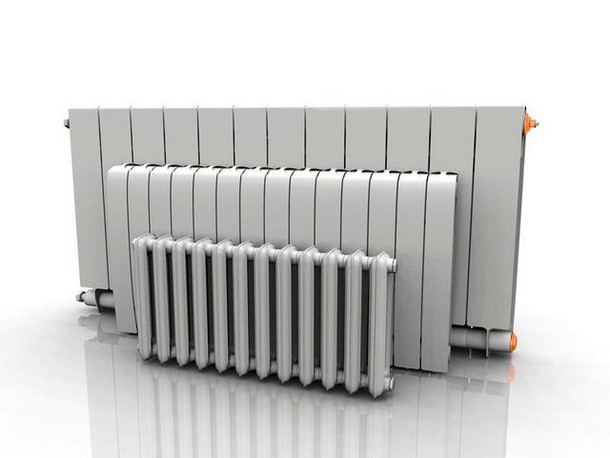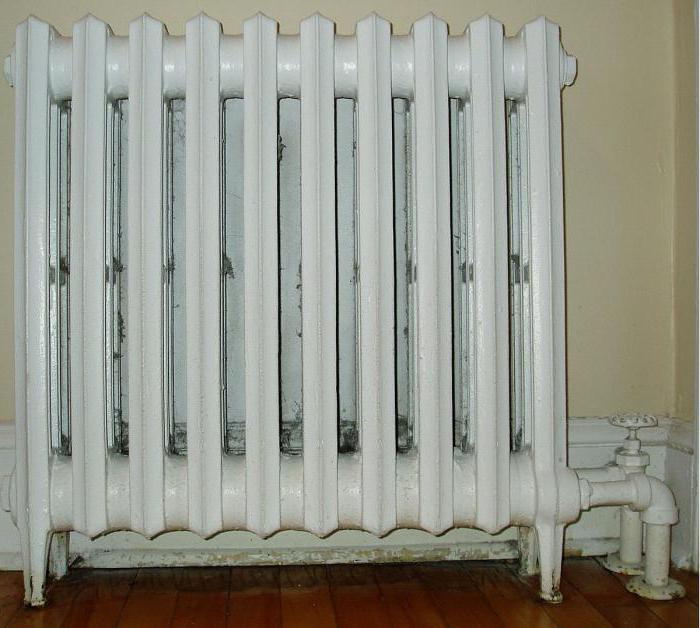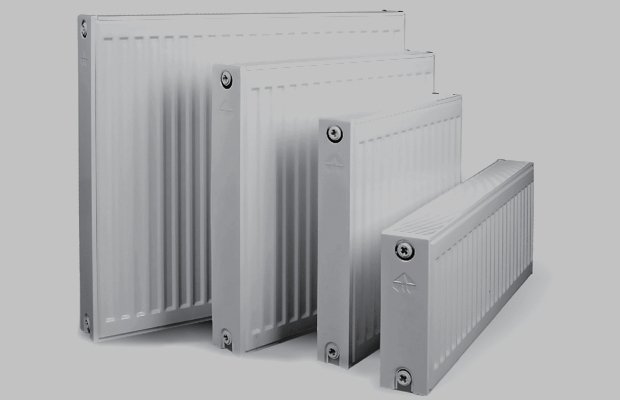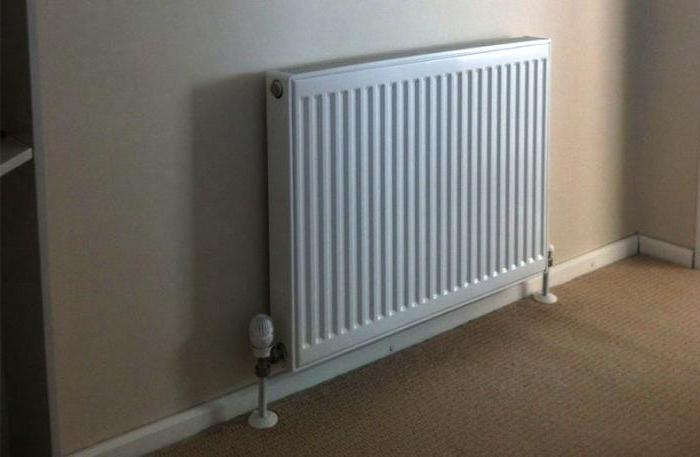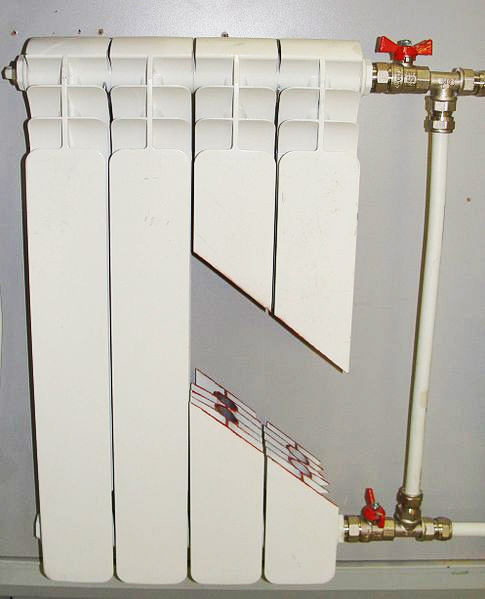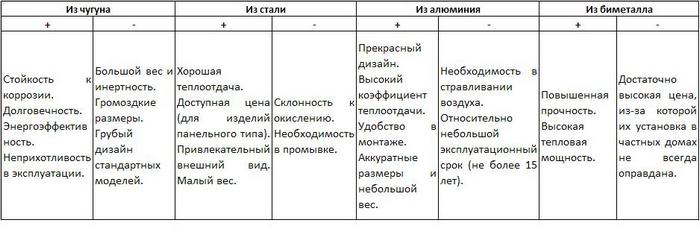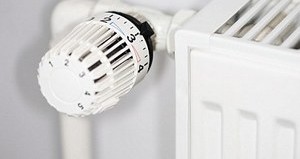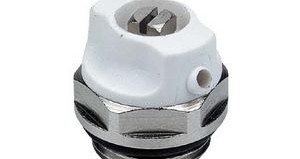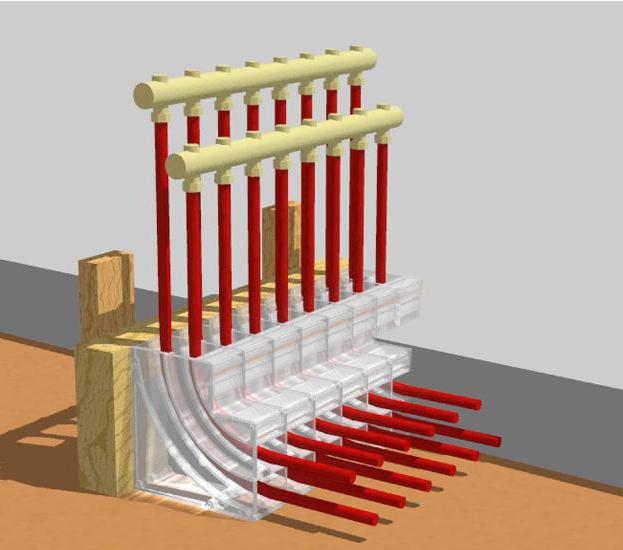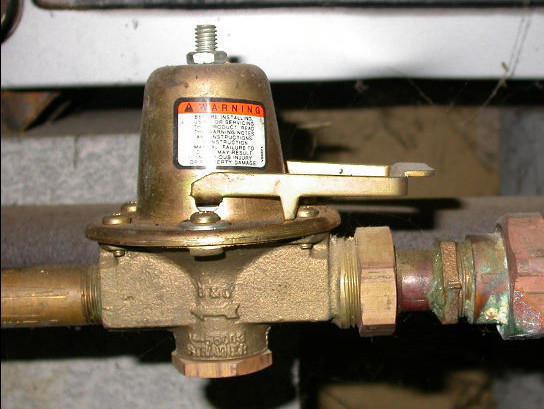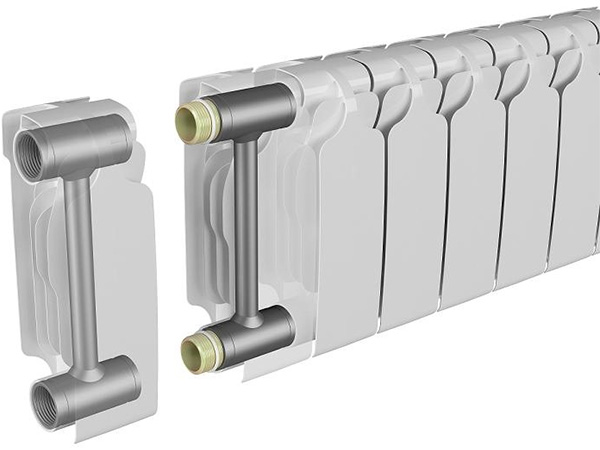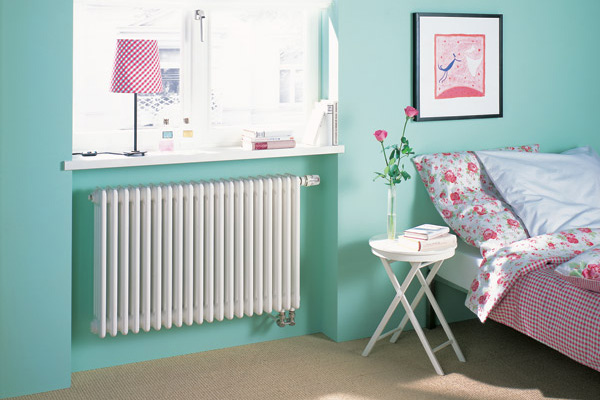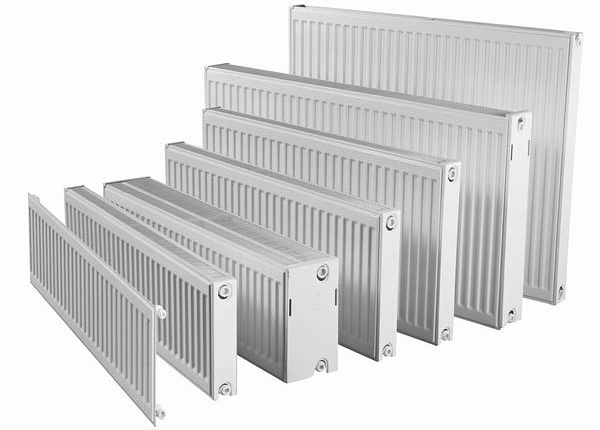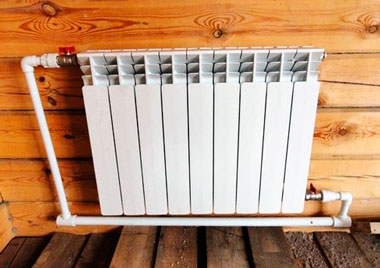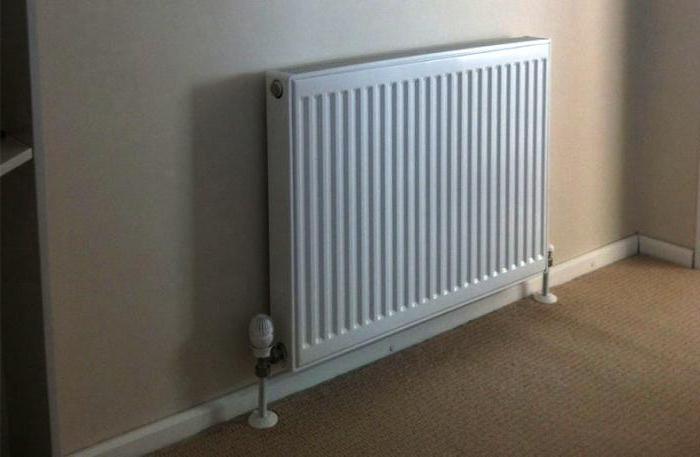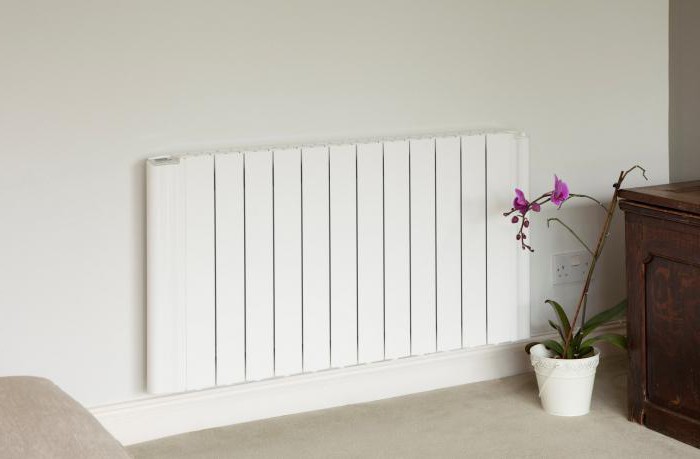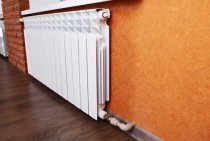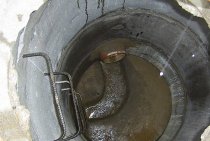How to determine the required diameter of the lines
When calculating the heating of a private house, you should, of course, calculate this indicator. If the diameter of the mains is chosen incorrectly, the system will not work effectively. To buy suitable pipes, you must first decide:
with the thermal power of the system;
optimal pressure of the coolant.
The first indicator is calculated by the formula Q=(V*Δt*K)*860, where V is the volume of the room, Δt is the difference between the air temperatures in the room and outside, K is the correction factor (depends on the degree of insulation of the building and is determined by a special table) .
The optimal speed of the coolant in the system is 0.36-0.7 m/s. The obtained value of thermal power and the selected pressure indicator should simply be substituted into the table for determining the diameter of the pipes.
As for the material of highways, in our time, both in small country houses and in cottages, metal-plastic is usually used. However, if desired, steel or even expensive and very durable copper pipes can be installed in a private residential building.
Lamellar convectors
There are different types of convectors. the most popular of them are accordions. Structurally, they consist of many plates mounted on pipes through which the coolant circulates. Some models have a protective casing so that a person cannot get to the heating elements and get burned. There are models with a heating element that run on electricity.
Photo: copper plate battery
- Strength (leaks or breaks are rare);
- High heat dissipation;
- Possibility of regulation of heat transfer by automatic equipment;
- Ease of installation;
- Automatic setting of operating modes for efficient use of the heating device (for electric models);
- Reducing the peak load in the power grid due to automatic regulation (for electric models);
- Possibility of installation on the floor, ceiling.
- Uneven heating of the air in the room;
- Difficulty removing dust
- Electric models raise dust, allergy sufferers may have problems.
Heating radiators for a country dwelling
Several parameters have a great influence on which radiators to choose for heating a private house. The main ones are:
- Profitability.
- Convenience during operation.
- The cost of equipment and installation.
Water heating is recommended for use in a house built of wood, brick, blocks. This option is much more economical to use when compared with a stove heated with wood and coal, as well as with electrical equipment.
For a private or suburban building, radiator heating is more suitable. This is due to the fact that the installation of batteries and pipelines is cheaper compared to water-type floor heating.
The differences between autonomous heating and central heating are as follows:
- Profitability.
- The ability to adjust the acid balance in the coolant.
- Temperature indicator adjustment.
- The risk of water hammer is completely absent.
- The operating pressure is within normal limits.
Aluminum Models
The main advantage of such radiators is their attractive appearance. Aluminum batteries look very modern and easily fit into almost any interior. They are inexpensive, but, like cast iron, they are rarely used in private homes. It's all about their increased demands on the quality of the coolant. In an acidic environment, aluminum reacts very quickly with the release of a rather large amount of gas. And this, in turn, leads to airing of the system and its failure.
Aluminum heating radiators for a private house, therefore, are well suited only when a sufficiently clean coolant is used in the mains. As for pressure, such models can easily withstand loads up to 15 atm.
Cast iron sectional radiators
The first development of cast iron batteries was carried out almost 150 years ago by our compatriot. A few years later, the Americans received a patent and finalized the design. Radiators gained popularity after the advent of the central heating system, and their mass production was adjusted during the industrial revolution.
The batteries that were used in the USSR and now remain in many homes have the MS 140 brand. The value "140" is the power given by one section. The operating and test pressure of the battery is 9 and 18 atmospheres, respectively. The number of sections is from 4 to 10.
Today, cast iron radiators are gaining popularity again, thanks to the improvement of their design and design.
The advantages and disadvantages of this type of battery are approximately the same.
- Long service life (more than 50 years);
- Affordable price;
- Resistance to mechanical damage;
- Corrosion resistance;
- High abrasive wear. Pebbles and sand in the water do not cause much harm to the battery from the inside;
- Heating efficiency at the maximum number of sections.
- Great weight and bulkiness;
- Possibility of depressurization of joints;
- Accumulation of rust inside during long-term operation;
- Unpresentable appearance;
- Difficulty in embedding radiators in autonomous heating systems, the impossibility of saving on the coolant;
- Difficulty cleaning.
Overview of different types
Before you purchase equipment so valuable for a comfortable life, you should analyze all the properties of radiators from different materials and understand which ones are better to choose for heating your private home.
Real "veterans" of the market. They are characterized by high performance, impressive durability and resistance to various kinds of loads. They have proven themselves when used in systems with high operating pressures - on average up to 10 bar.
The sections of such batteries have a fairly large volume and thick walls, which guarantees a fairly highly efficient heating. The service life of cast iron appliances in most cases significantly exceeds the 50-year indicator.
The heat transfer indicators of 1 section of the device can vary on average from 100 to 200 watts. The specific value is determined by the size of the compartment. Comparative characteristics of cast iron and bimetallic radiators you can see in this article.
In general, cast-iron batteries, known for their almost absolute resistance to contacts with low-quality coolants, are very popular among domestic consumers - operating features affect.
Radiators made of this material have proven themselves in private housing construction. The design features and raw materials are such that the finished product weighs much less compared to the previously considered cast-iron counterpart and has less thick walls, which ensures faster heating of the unit.
Modern steel batteries can be used in systems with a working pressure of up to 10 atm and a temperature of no more than +150 degrees. Models with horizontal and vertical channels are available for sale.
Additional advantages of such devices include a wide range of design solutions - batteries from the factory can have a variety of colors, which allows them to organically fit into any interior.
Aluminum
Aluminum products compare favorably with their "brothers" in light weight, elegance and high heat transfer rates.Such products combine 2 mechanisms of heat transfer: through convection and radiation, which makes them the most efficient devices for heating residential premises. At the same time, the permissible operating pressure in the system is also impressive - up to 18 atm.
Aluminum is characterized by high heat dissipation, which allows for the most efficient heating. In general, when using aluminum batteries, approximately 20-30% savings in thermal resource consumption are noted compared to devices made from other materials.
Bimetallic
Products are manufactured using high-strength steel (internal manifold) and aluminum (external part of the product) at the same time. In terms of operating pressure indicators, bimetallic batteries significantly exceed the previously considered options - up to 35 atm.
The combined use of aluminum and steel in the design of devices has made it possible to significantly increase their resistance to contact with a coolant, as well as their strength, resistance to corrosion damage, and heat transfer performance. At the same time, the units have relatively compact dimensions and, in general, a neat appearance.
Bimetallic heating radiators are characterized by relative ease of installation and are equally well combined with centralized and autonomous heating systems. How to calculate how many radiator sections you need, see here.
The design of the device is represented by seamless copper pipe. Other metals are not used in the manufacture of such units. The pipe diameter is about 2.8 cm. Additionally, there are copper fins and a decorative casing, usually made of solid wood.
In terms of thermal conductivity, copper exceeds aluminum by about 2 times, and cast iron and steel by an average of 5-6 times. In combination with low inertia, the radiator provides fast and efficient heating of the serviced premises.
The volume of the battery holds a little water, so that the unit warms up for 3-5 minutes. The mentioned property is especially relevant for autonomous heating systems - this eliminates the need for constant heating and "running" large volumes of coolant through the pipeline, as, for example, in the case of cast iron batteries.
Copper is resistant to corrosion. shows itself well when working in combination with a coolant with a low temperature, is characterized by high plasticity and resistance to aggressive media.
Features of heating in a private house
Not only the comfort of living in it in the winter period, but also the amount of material costs associated with heating and maintaining the house depends on how efficiently and competently the calculation is made, the selection and installation of heating devices is made. Therefore, first you need to choose the type of heating system that will be installed in it. She may be:
In the first case, space heating is carried out by means of furnace heaters or special electrical devices. including infrared heaters.
Stove heating is the cheapest and easiest way to heat, however, it has many disadvantages, such as:
- Long warm-up period.
- Low heat transfer coefficient compared to other energy sources.
- A high percentage of heat loss (most of the heat with such heating goes into the chimney).
Electric and infrared devices are a more advanced way of heating private houses, but their biggest drawback is the high cost and inaccessibility to a larger number of consumers, as well as the high costs associated with their operation.
A more popular and common option for heating a private house are water-type heating systems. in which space heating is carried out by heating water moving through radiators and pipes.
Their advantages in a private house compared to a centralized system include:
- Low pressure in the network;
- No likelihood of water hammer;
- Limited and adjustable coolant temperature;
- Ability to control the acid-base balance of the coolant.
In addition, they differ in ease of use, efficiency and cost-effectiveness.
4 Advantages and disadvantages of aluminum radiators
Autonomous types of heating in private houses are most often made in the form of a system of pipes and radiators, where hot water acts as a coolant. Such systems are called water heating. If you have such a system installed at your home, it is better to stop at aluminum heating radiators for a private house. They have benefits such as:
- light weight, which will allow you to install radiators even on fragile plasterboard walls;
- aesthetic appearance;
- high level of heat transfer;
- the ability to regulate the temperature with special taps.
Temperature control tap for aluminum radiator
However, aluminum products have some disadvantages, which it is desirable to know about in advance. So, for example, the coolant in such radiators must be free from chemical additives and solid particles that can destroy the material. In addition, aluminum radiators are known for not having the highest quality threaded connections, which increases the risk of leaks.
Cast iron radiators for an apartment
Such heating radiators are ready to serve more than 50 years. Some manufacturers urge to forget about such batteries, but in vain. After all, such devices in contact with dirty water will behave properly. This metal is chemically passive, it is not afraid of high acidity and the presence of chemical additives in the coolant. In addition, the abrasive will not be able to damage thick walls. That is why cast iron is perfect for an apartment heating system.
Such products keep heat for quite a long time, the residual number of its preservation is 30%. If we compare cast iron batteries with other radiators according to this criterion, then the former win
If you are wondering which radiators to choose for heating an apartment, then perhaps you should really pay special attention to cast iron ones, because they work on the principle of the radiant heat distribution method. It is much more efficient than convection
Cast iron does not rust when the batteries need to be drained in the summer. This feature is a significant plus. The heat transfer of such devices is quite large. With pressure drops that occur during the operation of central heating, cast iron behaves quite adequately. However, the material is not always able to withstand high power hydraulic shocks - in this case, the fragility of the walls can fail.
The determining factor for the choice is sometimes the cost, which is much lower in the case of the described models. However, during installation, cast-iron radiators are heavy. It is worth mentioning that the weight is due to the impressive wall thickness, which provides the necessary strength to the products. If you install cast-iron radiators once, you can forget about replacing them for many years.
Cast iron radiators
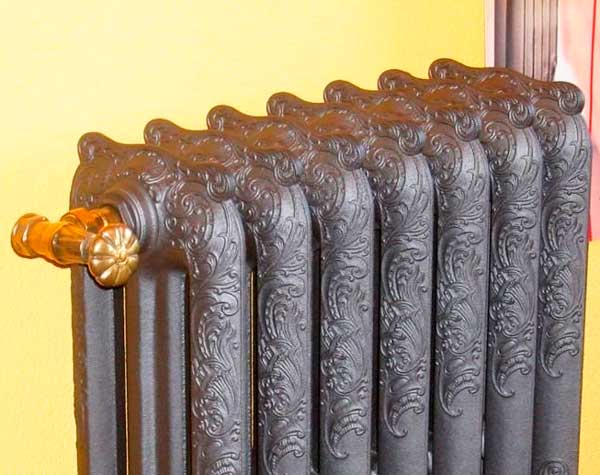
Cast iron batteries heat up for a long time, but cool down for a long time. The residual heat retention number is twice that of other types and is 30%.
This makes it possible to reduce the cost of gas for home heating.
Advantages of cast iron radiators:
- Very high resistance to corrosion;
- Durability and reliability that have been tested over the years;
- Low heat transfer;
- Cast iron is not afraid of exposure to chemicals;
- The radiator can be assembled from a different number of sections.
Cast iron radiators have only one drawback - they are very heavy.
The modern market offers cast-iron radiators with decorative design.
6 How to choose a heating radiator depending on the power
How to choose the right heating radiators for a private house? Here, not only the appearance of the products is important, but also the power - when buying a device, you need to find out how much power is needed to heat the system. This is not as difficult to do as it might seem at first. So, for heating one square meter in a room with a ceiling height of three meters and one window, about 100 watts are needed. Then simply multiply the area of the room by 100 watts. And to make the calculations even more accurate, do not forget:
- if the room has one window and two external walls, add about 20% more to the calculated power;
- if there are two windows and two external walls - we add about 25-30%;
- when the window faces the northern part, it is worth adding at least 10% to the calculations.
Having carried out such calculations, you can more accurately choose the right radiator for your home. And the power of the devices can always be viewed in the documents - the “passport” of the device
By the way, it doesn’t matter at all which radiators you decide to choose for installation in a private house, if you install them incorrectly, they will decorate your home, but will not provide the necessary heat to heat the room.
The choice of radiators for a country house
Let's look at where to mount radiators - this information will definitely be useful to you when you create a heating scheme. So, batteries should be placed under light openings - windows. This place always has the most heat loss, even if you have modern double-glazed windows installed. A radiator placed under the window will warm the air around it. After that, the heated air rises and creates a curtain in front of the window that prevents the penetration of cold into the room.
When choosing which heating radiators are best purchased for a private house, do not forget about the importance of the length of the appliances - it must correspond to the width of the window opening. In extreme cases, the length should be at least 50% of the width of the window
In a corner room, it is worth placing 1-2 additional devices along the outer walls exposed to cold air. If you are going to install heating risers, mount them in the corners, which will ensure their heating and avoid the possibility of blackening of the walls and the appearance of mold in them.
And do not forget that access to the batteries must be open. Many owners of private houses cover heating radiators with drywall sheets, which is undesirable - this will complicate the process of cleaning and repairing appliances if necessary. In addition, the use of such a fence will lead to a revision of previously performed power calculations.
We told you how and which radiators are best to choose for installation in a private house. Now you know that when buying appliances, you need to consider the quality of the water in the pipes, the power of the devices, their appearance, and even the ability to install on fragile partitions, if necessary.
Bimetallic batteries
When answering the question of which heating radiator is best for a private house, it is worth thinking about purchasing a model of this type in the first place. Bimetallic batteries are currently perhaps the most popular type of such equipment. The design of radiators of this type includes elements made of two types of metal - aluminum and steel (or copper). Hence their name. The advantages of bimetallic radiators, among other things, include:
the ability to withstand very high coolant pressure (up to 35 atm) and water hammer;
attractive appearance;
durability (can last up to 25 years).
In general, bimetallic heating radiators for a private house are best suited.Reviews of models of this type available on the network clearly indicate this. Owners of suburban real estate consider such equipment to be very high quality, easy to install and operate. In appearance, such radiators resemble aluminum ones, but at the same time they are much more reliable. Their design is such that they look like a monolithic product. Since the performance of such batteries is better than that of aluminum, they are slightly more expensive (by about 25%).
Aluminum radiators
Aluminum radiators enjoy well-deserved popularity among buyers. They have many advantages: they are light, compact, give off a lot of heat to the environment, what else do you need? But, there are also disadvantages:
- Gas formation is possible (it is impossible to let “anti-freeze” into the batteries);
- Aluminum is subject to corrosion (to prevent this, a chemical-neutral film is applied to the product);
- Possible leaks in the seams;
- A short period of work - up to fifteen years. Some manufacturers have been able to increase this by several years;
- Sensitivity to pressure drops in the system, which is often observed in multi-storey buildings;
- Sensitivity to the composition of the coolant.
Sectional aluminum radiator
Aluminum radiators
Aluminum radiators enjoy well-deserved popularity among buyers. They have many advantages: they are light, compact, give off a lot of heat to the environment, what else do you need? But, there are also disadvantages:
- Gas formation is possible (it is impossible to let “anti-freeze” into the batteries);
- Aluminum is subject to corrosion (to prevent this, a chemical-neutral film is applied to the product);
- Possible leaks in the seams;
- A short period of work - up to fifteen years. Some manufacturers have been able to increase this by several years;
- Sensitivity to pressure drops in the system, which is often observed in multi-storey buildings;
- Sensitivity to the composition of the coolant.
Sectional aluminum radiator
Cast iron batteries
The main advantages of this type of radiators are low cost and durability. Cast iron batteries are not subject to corrosion and can last up to 50 years. In addition, they are undemanding to the quality of the coolant and easily withstand quite a serious pressure in the system - up to 12 atmospheres.
The advantages of cast-iron models, therefore, have a lot, and therefore, in some cases, they can be an excellent answer to the question of which radiators to choose for heating a private house. However, despite the large number of advantages, such batteries are installed quite rarely in residential suburban buildings. The thing is that Soviet radiators of this variety look too old-fashioned. It is almost impossible to fit them harmoniously into a modern interior. In addition, these batteries are very heavy and can be used mainly only in buildings with very strong walls. For example, for a house built of foam concrete, they are absolutely not suitable.
Cast iron heating radiators for a private house are suitable, but when deciding to choose just such models, it is worth bearing in mind that they do not differ in particularly high efficiency. Such batteries warm up rather slowly, and their heat transfer is not particularly large.
Cast iron radiators
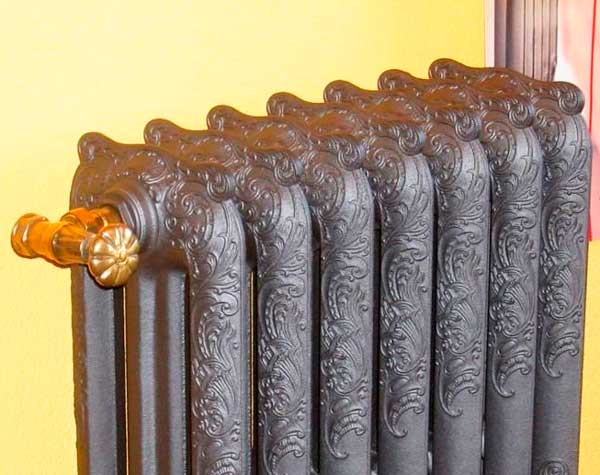
Cast iron batteries heat up for a long time, but cool down for a long time. The residual heat retention number is twice that of other types and is 30%.
This makes it possible to reduce the cost of gas for home heating.
Advantages of cast iron radiators:
- Very high resistance to corrosion;
- Durability and reliability that have been tested over the years;
- Low heat transfer;
- Cast iron is not afraid of exposure to chemicals;
- The radiator can be assembled from a different number of sections.
Cast iron radiators have only one drawback - they are very heavy.
The modern market offers cast-iron radiators with decorative design.
Comparison of batteries for a private house
In order to figure out which radiators are better to choose for heating a private house, you can make a small comparative analysis, evaluating the advantages and problem areas of each type:
We will separately consider the technical parameters of heating batteries of various types and the possibility of their installation in a private house:
Indicator of working pressure, atm.
Low (excluding original decorative models)
Thus, the question of which heating radiators are better for a country house can be answered that, based on material, practical considerations and ease of installation, the choice should be made in favor of aluminum or steel batteries, which have many advantages and have a low price. Also, the video will help you figure out which heating batteries are better to choose in a private house.
https://youtube.com/watch?v=cWR96Fnc1mA
plumbing fixture installer
1 comment
Based on personal experience, I will say that for a private house in terms of price-quality-appearance-weight-installation complexity-heating efficiency, aluminum radiators are the best option. With a good gas boiler in the house in winter it becomes very comfortable. If your hands grow from the right place, then for the installation of the heating system I advise you to make a pipeline from metal-plastic pipes. It will turn out a little more expensive than pipes made of polypropylene or steel, but special equipment is not needed for installation. It is enough to have wrenches for 24, 27.30 and 32 mm or gas wrench No. 1 or No. 2 with a good adjustable wrench. The service life of such heating is 15-30 years. P.S. Pipes, fittings and radiators should never be Chinese!
Poll Options are limited because JavaScript is disabled in your browser.
How to determine the required diameter of the lines
When calculating the heating of a private house, you should, of course, calculate this indicator. If the diameter of the mains is chosen incorrectly, the system will not work effectively. To buy suitable pipes, you must first decide:
with the thermal power of the system;
optimal pressure of the coolant.
The first indicator is calculated by the formula Q=(V*Δt*K)*860, where V is the volume of the room, Δt is the difference between the air temperatures in the room and outside, K is the correction factor (depends on the degree of insulation of the building and is determined by a special table) .
The optimal speed of the coolant in the system is 0.36-0.7 m/s. The obtained value of thermal power and the selected pressure indicator should simply be substituted into the table for determining the diameter of the pipes.
As for the material of highways, in our time, both in small country houses and in cottages, metal-plastic is usually used. However, if desired, steel or even expensive and very durable copper pipes can be installed in a private residential building.
How to choose a boiler
So, we found out which heating radiator is best for a private house. If desired, for a country building, you can choose both cast iron and aluminum, steel or bimetallic batteries. In this case, everything depends mainly only on the quality of the coolant, the pressure in the system and the features of the interior of the premises. However, when drawing up a project, of course, one should determine the characteristics of other necessary equipment. In particular, it is imperative to calculate the power of the boiler. Modern industry produces four types of such equipment:
These are the boilers for heating a private house that are mainly on sale today. How to choose a specific type of such equipment is actually not a very difficult question.Most often, gas boilers are installed in houses. Installing them is usually quite expensive. But at the same time, such equipment is quite economical and convenient to use. Electric boilers are cheap, but they are expensive to operate. Therefore, they are most often installed only if there is no gas main near the house.
Solid fuel and diesel heating boilers are used mostly in buildings built in remote areas. That is, where there is no gas and no power lines. Such equipment is usually quite expensive and at the same time not very convenient to use.
Classes of heating radiators
There are 4 classes of heating devices:
Sectional type radiators are known to everyone. They are made of cast iron, aluminum, steel. There are models for the production of which two materials are used (usually steel and aluminum). Such batteries are called bimetallic. Sectional radiators are assembled from separate sections (sections), obtaining at the output a heater with the required power, which is given to the external environment during operation.
Sectional radiators are assembled from separate sections (sections)
Plate heaters are called so because they are made of several plates mounted on curved or straight pipes. The heat carrier (water) circulates through the pipes. Another name for plate heating devices is convectors. They can be electrical or non-electric.
Photo: tubular radiator in the interior
Tubular radiators are made of several tubes interconnected by collectors. They look pretty original. Such radiators are often found in apartments where the interior is made by professional designers. Pipes can be made in any size and shape, for example, in the form of a specific shape.
Photo: panel radiators of different sizes
Panel heating radiators consist of panels that receive heat from the coolant circulating in the space between them through the channels formed by stamping. There are models with one, two and three panels.
Let us consider in more detail each of the types of heating radiators.
Choosing heating radiators for a private house which is better
Consider the main advantages of the heating system of a private house:
- Its work is carried out at low pressure, which favorably affects the operation;
- In this system, there are no large hydro-shocks, this provides a wide range of radiators;
- Observing the necessary technical conditions for the acid balance of water, the choice of radiators is very wide.
Taking into account the above, the choice of radiators should be made taking into account the maximum heat transfer coefficient and good value for money. Without going into details, any type of radiators can be operated in a private house. But knowing the advantages of one or the other still does not hurt.
For the manufacture of radiators, the following types of materials are used: cast iron, aluminum, metal (steel), bimetal.
Bimetallic batteries
When answering the question of which heating radiator is best for a private house, it is worth thinking about purchasing a model of this type in the first place. Bimetallic batteries are currently perhaps the most popular type of such equipment. The design of radiators of this type includes elements made of two types of metal - aluminum and steel (or copper). Hence their name. The advantages of bimetallic radiators, among other things, include:
the ability to withstand very high coolant pressure (up to 35 atm) and water hammer;
attractive appearance;
durability (can last up to 25 years).
In general, bimetallic heating radiators for a private house are best suited. Reviews of models of this type available on the network clearly indicate this.Owners of suburban real estate consider such equipment to be very high quality, easy to install and operate. In appearance, such radiators resemble aluminum ones, but at the same time they are much more reliable. Their design is such that they look like a monolithic product. Since the performance of such batteries is better than that of aluminum, they are slightly more expensive (by about 25%).
Popular electric heating batteries and their functionality
Throughout its development, man has sought to improve the heating of the home. Primitive fires were replaced by stoves and fireplaces that heated the house locally or centrally, and later heat was supplied through specially designed systems.
Today, private houses are heated with water or steam heating batteries, which are heated by gas. But this type of heating is acceptable for areas where connection to the central highway is possible. What should consumers who are unable to connect to gas do? Electric radiators for space heating are a worthy replacement for water radiators heated by gas or solid fuel.
Aluminum Models
The main advantage of such radiators is their attractive appearance. Aluminum batteries look very modern and easily fit into almost any interior. They are inexpensive, but, like cast iron, they are rarely used in private homes. It's all about their increased demands on the quality of the coolant. In an acidic environment, aluminum reacts very quickly with the release of a rather large amount of gas. And this, in turn, leads to airing of the system and its failure.
Aluminum heating radiators for a private house, therefore, are well suited only when a sufficiently clean coolant is used in the mains. As for pressure, such models can easily withstand loads up to 15 atm.
Choosing a battery for a private house
One of the important advantages of the heating system of a private house is low pressure, which is favorable for radiators. Water hammer is practically excluded here, and subject to the technical conditions of the water balance, the list of battery selection becomes quite extensive.
Tubular radiators are convenient for drying things, which is important for families with children. Now you know how to choose the right heating radiator for your apartment
But if you live in a house, then you should pay special attention to steel radiators, which are distinguished by low oxidization from low-quality water, as well as light weight and convenient dimensions. The service life of such devices is quite long.
But steel radiators also have disadvantages. They are expressed in a not too attractive design, the need for flushing, as well as the requirements for constant fullness. The last recommendation is due to the fact that the inner walls will rust in the absence of water, and this can “kill” the radiator within just a few years.
Conclusions regarding the choice of a radiator for an apartment
In conclusion, we can conclude which heating radiator is better to choose for an apartment. As practice shows, aluminum and steel models are not able to withstand the tests that accompany operation in the conditions of domestic heating systems. Such batteries are not able to withstand pressure and temperature changes. There are only cast-iron and bimetallic devices to choose from.
What to buy - you can decide by evaluating the budget, as well as the characteristics of the models. However, there are a few tips you can use. If you still do not know which heating radiator is best for an apartment, then you should evaluate how old the house you live in is.If we are talking about "Khrushchev", then it is best to use cast iron products. For residents of high-rise buildings, where the pressure is higher, it is recommended to purchase bimetallic radiators. If earlier cast iron batteries were installed in the apartment, then the choice can be stopped on any of the two options. However, those who are going to replace a battery made of another metal should purchase bimetallic models.
